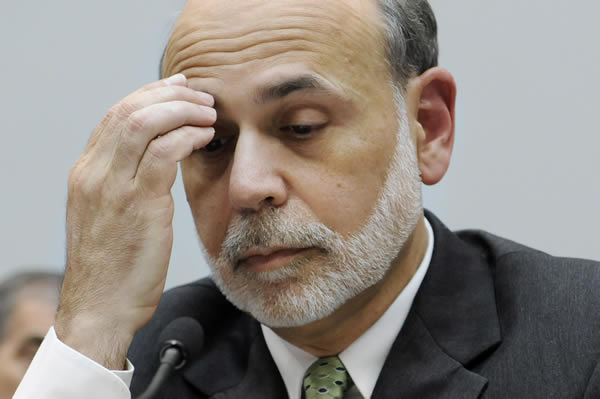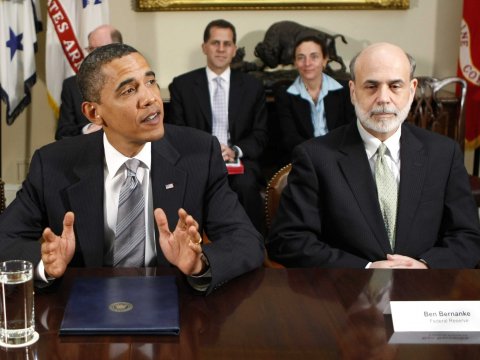Bonds & Interest Rates
What’s most significant about the Federal Reserve’s latest statement is what it did not address: tapering bond-buying and future policy guidance.
FORTUNE — After the discomforting volatility of May and June, the Federal Reserve opted today for market tranquility. As a result, two (if not three) consequential decisions are now pushed to September — raising the question of whether the current pursuit of market calm will develop deeper roots in the interim or, instead, come at the cost of greater instability down the road.
The three main things that the Fed told us this afternoon at the conclusion of a two day policy meeting can be read about HERE

The statement contained no new language on the conditions for maintaining the current pace of asset purchases. The Fed repeated the pledge it has used since September that it will continue the purchases until the U.S. labor market outlook has improved substantially.
Policy makers also left unchanged their commitment to hold the target interest rate near zero as long as the jobless rate remains above 6.5 percent and the outlook for inflation over one to two years doesn’t exceed 2.5 percent.
Speculation about the Fed’s $85 billion in monthly bond purchases has whipsawed stocks since May, when Chairman Ben S. Bernanke first indicated policy makers could begin reducing the stimulus this year if the job market continues to improve.
A Commerce Department report earlier today showed that gross domestic product, the value of all goods and services produced, rose at a 1.7 percent annualized rate, after a 1.1 percent gain the prior quarter. The median forecast of 85 economists surveyed by Bloomberg called for a 1 percent advance for last quarter.

Here’s what to look for when the Federal Open Market Committee releases a statement at 2 p.m. tomorrow after a two-day meeting in Washington. Unlike last month, the policy-making panel will not release economic forecasts, and Chairman Ben S. Bernanke will not be briefing the press afterwards.
— Possible clarification in the statement on the likely path of the Fed’s bond buying, currently $85 billion a month. Bernanke said in a news conference on June 19 that the central bank may begin reducing the pace of purchases “later this year” and may end the program about the middle of 2014, assuming the economy performs as forecast by the Fed. By the time the program ends, unemployment will be around 7 percent, Bernanke said. The rate was 7.6 percent in June.
“We are looking for the FOMC to formalize a version of the guidelines for tapering QE laid out by Chairman Ben Bernanke,” Julia Coronado, chief economist for North America at BNP Paribas in New York, wrote in a research note. The statement will probably say that the committee expects to begin trimming the purchases later this year; that the reduction will come in “measured steps” if the economy continues to improve and inflation rises closer to the Fed’s target; and that the program will end when unemployment is around 7 percent, she said.
— An emphasis from the FOMC that it expects to pursue accommodative policy for the foreseeable future, even after the committee concludes its so-called quantitative easing program, according to Neal Soss and Dana Saporta, economists at Credit Suisse Group AG in New York. The FOMC has kept its benchmark interest rate near zero since December 2008.
Economist Survey
— No change in the pace of bond purchases. None of the 54 economists surveyed by Bloomberg July 18-22 expected the FOMC to begin paring asset purchases at the meeting ending tomorrow. Half predicted a dial-back of the program to $65 billion per month in September.
— An acknowledgement that low inflation has been more persistent than expected, which would “would be seen as dovish, as would a more explicit commitment to defend their inflation target from below,” according to a research note from Bank of America Corp. in New York. The Fed’s preferred price gauge showed that inflation was at 1 percent in May, compared with the central bank’s 2 percent target.
— Renewed dissents from St. Louis Fed President James Bullard and Kansas City’s Esther George, according to Michael Feroli, chief U.S. economist at JPMorgan Chase & Co. in New York. Bullard has repeatedly voiced concerns about low inflation, while George has said the Fed’s record accommodation risks leading to financial imbalances.
To contact the reporter on this story: Aki Ito in San Francisco at aito16@bloomberg.net.
To contact the editor responsible for this story: Christopher Wellisz at cwellisz@bloomberg.net

 One of Pimco’s top thinkers, market strategist and portfolio manager Tony Crescenzi defines three important takeaways from the chairman’s testimony (in his report to congress) that Pimco believes have shelf life.
One of Pimco’s top thinkers, market strategist and portfolio manager Tony Crescenzi defines three important takeaways from the chairman’s testimony (in his report to congress) that Pimco believes have shelf life.
With this week bringing a policy statement from the Federal Open Market Committee, as well as a jobs report, a GDP report, and a slew of other indicators its probably a good idea to…….
….review all 3 HERE

 The Next Few Months Will See An Extraordinary Confluence Of Rare And Significant Economic Events.
The Next Few Months Will See An Extraordinary Confluence Of Rare And Significant Economic Events.
First and foremost on the minds of financial market participants is the Federal Reserve’s monetary policy meeting on September 18, upon conclusion of which the FOMC is expected to announce a reduction in the pace of its monthly bond purchases to $65 billion.
…..read about the rest HERE












